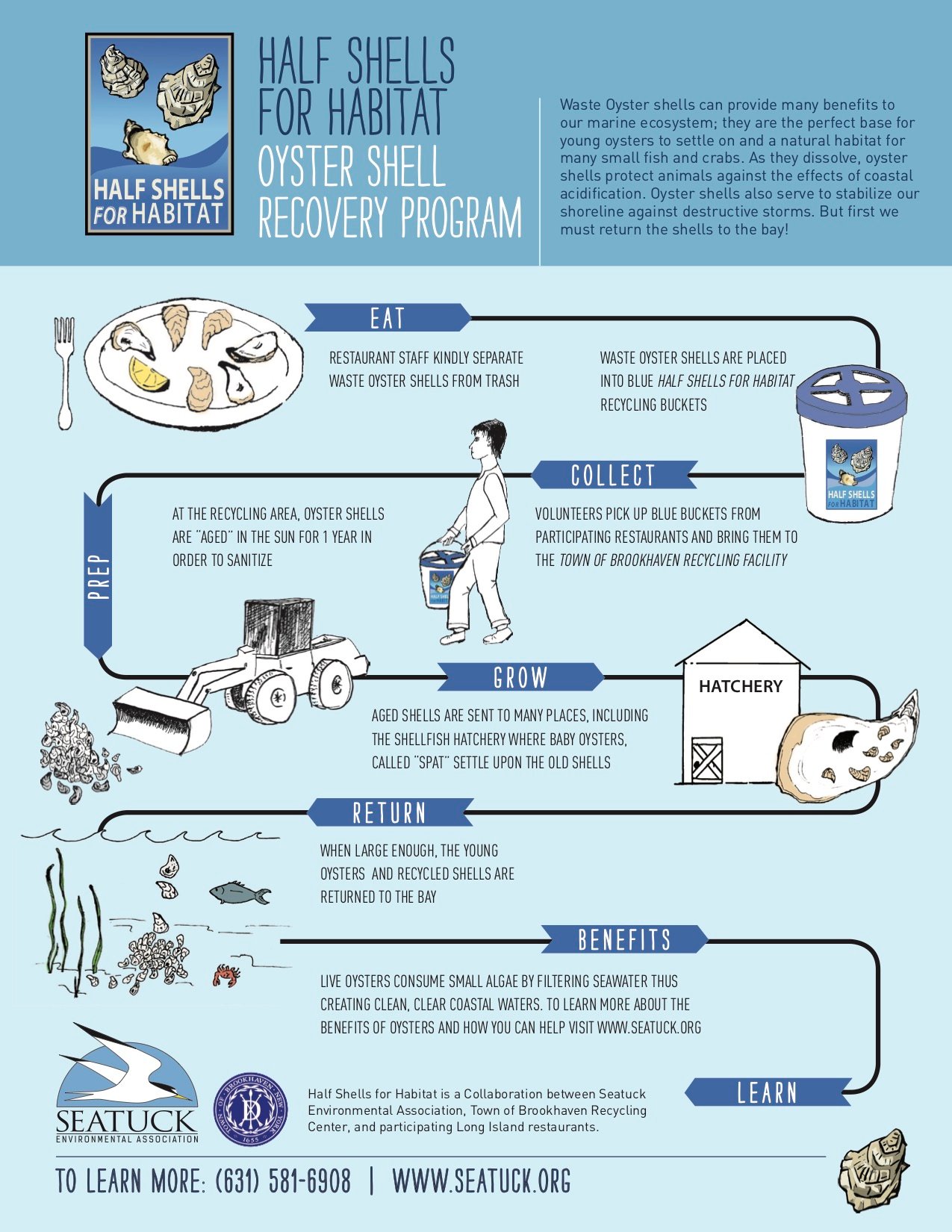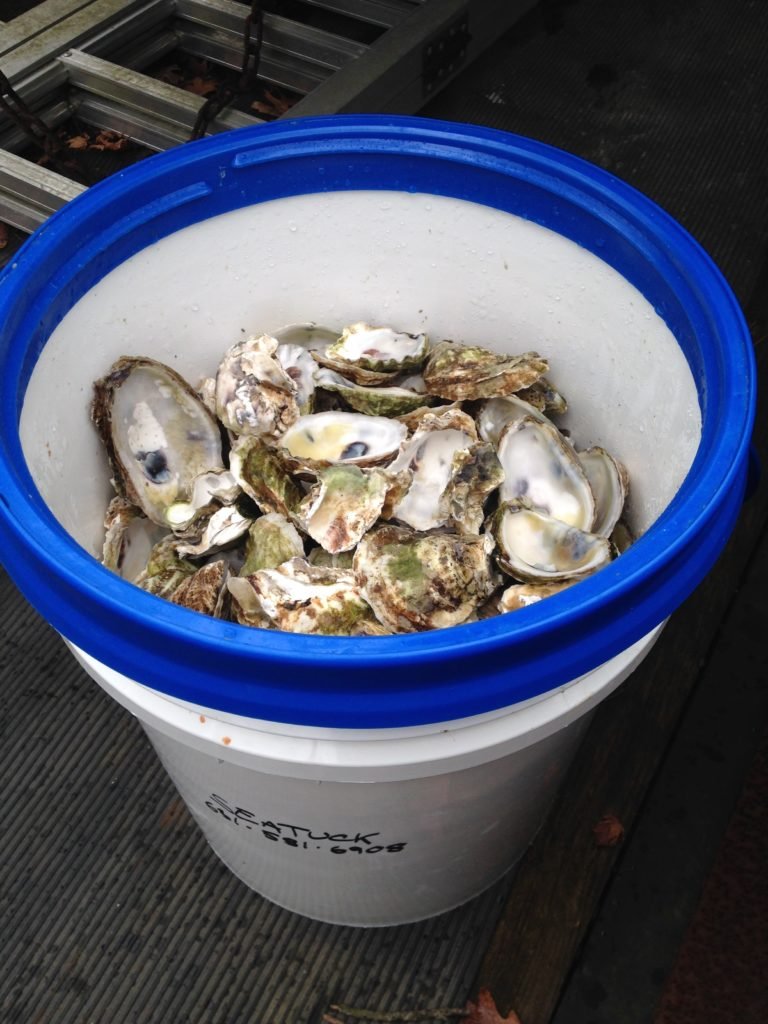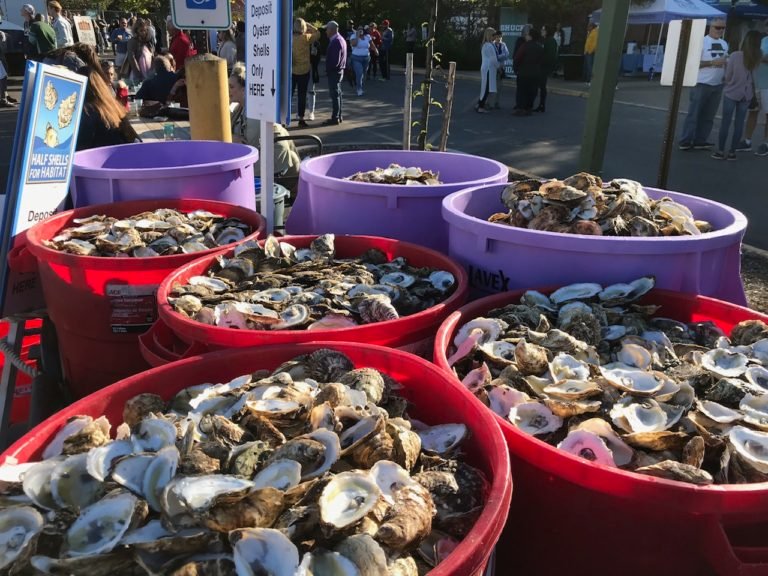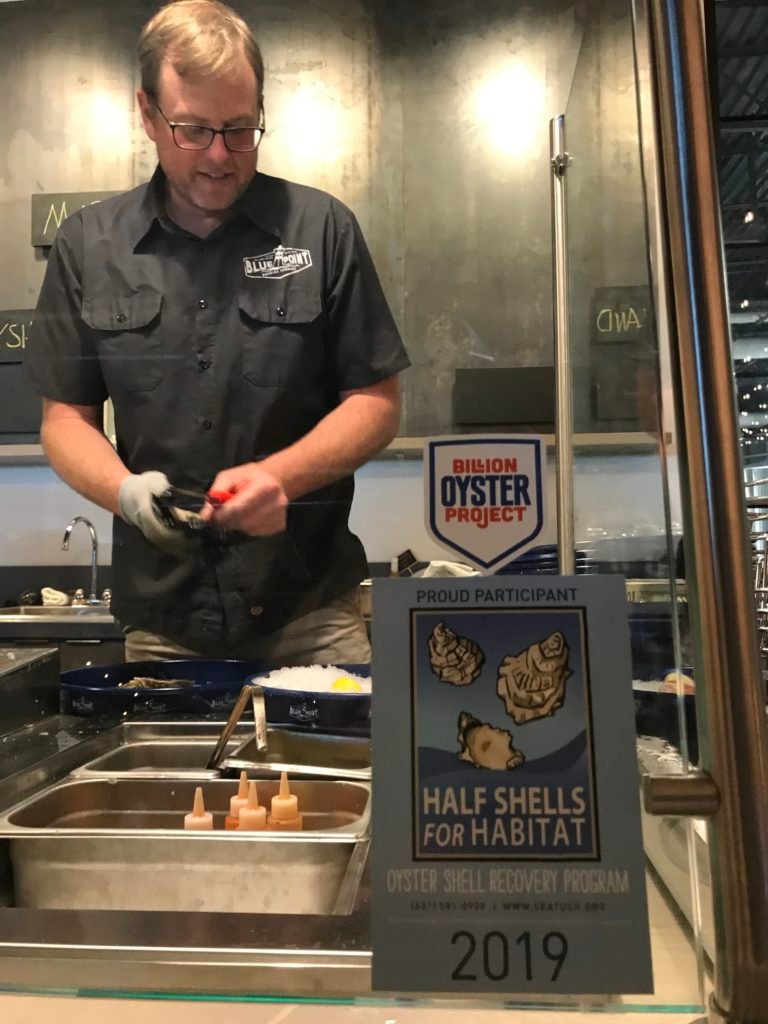Half Shells for Habitat

Half Shells for Habitat
Oyster Shell Recovery Partnership
Half Shells for Habitat (H4H), which was initiated by Seatuck and a host of partners in 2018, is an island-wide program to recover oyster shells from restaurants for use in oyster and habitat restoration efforts.
The program was established to address the critical need to return oyster shells to Long Island’s estuaries. The shells provide vitally important substrate on which wild young oysters can attach and grow, and they help to combat coastal acidification by returning calcium carbonate to the water.
With funding from
NEED CURED OYSTER SHELLS?
Click here to request a donation to your project.
Muncipal Partners
After launching with the Towns of Brookhaven and Hempstead as municipal partners, Half Shells for Habitat now also includes the Towns of Huntington, Islip, North Hempstead and Riverhead, as well as the Villages of Ocean Beach, Port Jefferson and Sag Harbor. These municipal partners provide facilities for shell storage and curing and other critical support for the program.
If your town is interested in joining this environmental program, please contact us at: mdunn@seatuck.org or 631-581-6908.
Non-profit & Other Partners
Seatuck water quality scientist, Maureen Dunn (pictured at right with Seatuck board member Charlie Weiss), established and continues to manage the H4H partnership. In addition to Seatuck, the program relies on a host of other non-profit organizations, businesses and (most importantly!) volunteers to coordinate an island-wide shell collection effort. To date, the team has partnered to collect well over 100,000 pounds of oyster shells!
And since it began distributing cured oyster shells in May 2019, H4H has returned nearly 50,000 pounds of cured shells to our bays through various oyster restoration and reef-building projects, including Cornell Cooperative Extension’s Long Island Shellfish Restoration Project, the Huntington-Northport Oyster Reef project, Stony Brook University’s Shinnecock Bay Restoration Program, Adelphi University’s CORE program and the Moriches Bay Project.

Participating Restaurants
Halfshells for Habitat was initiated with the generous cooperation of several restaurants, with Catch Oyster Bar (Patchogue), H2O (East Islip), The Snapper Inn (Oakdale), The Cull House (Sayville) and Vincent’s Clam Bar (Carle Place) joining the program as early participants. The list of current participating has continued to grow after a slow-down during the COVID pandemic. The full list of participating restaurants currently includes the following:
How it Works
H4H relies on an well-oiled “collection collaborative” to recover oysters shell from restaurants and festivals and ensure they are returned to Long Island’s bay.

10 Benefits of Shell Recovery
& Oyster Restoration
1. Enhanced Water Quality and Clarity – Oysters consume microscopic algae called phytoplankton, which helps to clarify seawater and promote eelgrass growth. In addition, the removal of harmful phytoplankton decreases the likelihood of harmful algal blooms, such as Brown and Rust Tides.
2. Habitat for Wild Oyster Restoration – In many bays, wild oysters can’t take hold because of the lack of the hard substrate they require for attachment. This substrate, which was historically provided by other oyster shells, is restored when recovered shells are returned to the water. They provide the necessary substrate for “wild set” oysters, which are important for natural disease resistance and genetic diversity in overall oyster populations.
3. Regulating Nitrogen Pollution – Oysters grow well in nitrogen-rich waters. They remove nitrogen from seawater by consuming phytoplankton that have the ability to incorporate nitrate. At harvest time, farmed oysters and the nitrogen they’ve consumed are removed from the environment. The consumption of wild oysters by transient wildlife also serves to rid the local environment of excess nitrogen.
4. Reduce Landfill/Incineration – Recycling oyster shells reduces the cost of delivering and disposing of them as waste in landfills or burning them in incinerators.
5. Shoreline Stabilization – Oyster shells can be used to stabilize eroding shorelines in salt marshes, or as part of a reef building process with the reintroduction of live oysters. Oyster reefs mitigate the damaging wave effects of severe storms and hurricanes. As sea level rises at an ever-accelerating rate, these efforts will help protect our shorelines.
6. Mitigate Coastal Acidification – Excessive algae growth in Long Island’s coastal waters fuels high levels of the bacteria that decompose the algae. The bacteria use oxygen and produce CO2 as they respire. This increased CO2 lowers the pH of the water (already low from atmospheric absorption of CO2 in ocean waters), causing what is known as “coastal acidification.” This condition, which is increasing around Long Island, presents a significant threat to our estuaries and wildlife (including young oysters, which are especially sensitive to pH changes). The calcium carbonate of recycled oyster shells provides a buffer against coastal acidification, acting like an antacid as they dissolve.
7. Provide Mesohabitat – Wild oyster reefs provide important habitat for small fsh, shrimp and juvenile crustaceans. While aquaculture structures can mimic this habitat, it is removed at harvest time and lost. Wild oyster reefs are necessary to provide permanent, long-term mesohabitat for marine wildlife.
8. Carbon Sink – Shells are made of calcium carbonate; when burned as kitchen waste they emit carbon into the atmosphere. However, when bound together in an oyster reef, the same shells instead serve as a carbon sink.
9. Community Involvement and Education – Shell recovery and restoration relies on volunteers to collect shells from participating restaurants, assist with spat-on-shell rearing and a wide range of other jobs. In the process, it educates volunteers and empowers them as ambassadors to engage the general public in the work to protect and restore our coastal ecosystem.
10. Quality of Life & Tourism – Oysters not only enhance the health of our coastal waters, but they are also a prized culinary delicacy for which Long Island is renown. These important roles are both critical in supporting the quality of life and tourism that is so vital to Long Island’s economic health.


